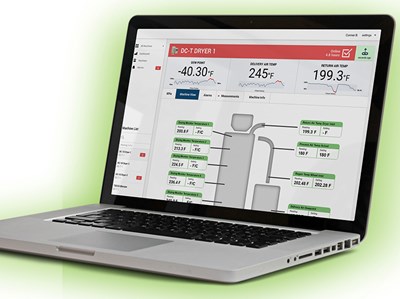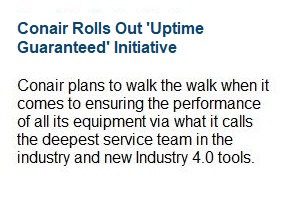How Machine Monitoring Delivers Tangible Results
Sponsored ContentMuch more has been said than done about reaping the benefits of data driven manufacturing among plastics processors. Good technology is essential, but change management is the most difficult part of the process. Here’s how to think about both.
Share
Most plastics equipment manufacturers now offer some form of digital connectivity to serve the vision of Industry 4.0. But for most processors it’s not so simple as plugging in the equipment and waiting for the magic to happen. Moving toward a digital manufacturing model is as much about change management as it is about technology, though the technology you choose is extremely important to realize tangible benefits from your investment.
Conair, the well-known plastics auxiliary equipment manufacturer has been working with processors to affect this change for five years now and has learned a lot about the process. Conair’s enabling technology for this is its SmartServices® platform, a cloud-based solution for connecting auxiliary equipment. It offers the ability to connect all of your plastics processing equipment (even older or non-Conair equipment) to a single web-based dashboard, analyzing equipment data and converting it into usable, actionable information for operators, maintenance technicians, plant managers, and even procurement specialists.
But having the tech is one thing. Getting it productively implemented is quite another. Here’s Conair’s take on getting it done.
Managing Change
We’ll get to the technology in a moment, but first we must talk about change management. According to Conair’s business development manager for SmartServices, Andrew Novick, “Conceptually digital transformation can be intimidating, but having a partner like Conair who supports the change management process by ensuring proper installation and training maximizes the benefits of digital manufacturing.”
Doing that requires engaging key stakeholders at every level of the organization. Key players in this process:
- The Champion – A significant change project in any organization needs a champion. In most companies this is not someone from executive management, but nonetheless someone well positioned to understand all the ramifications of the project from financial to technical to operational. The champion is the driver of the project who is respected and trusted by all levels of management as well as by plant floor workers.
- The Coach(es) – This is the person who really understands how your operation works at the user level and that fellow employees respect. Not necessarily a supervisor, the coach nonetheless has influence on the team and can help realistically assess the challenges of the effort. Engaging the coach will help you make better decisions and help other team members buy into the project.
- The Executive – In times of change executive management needs to do more than just green light the project. It needs to create an environment where employees understand why change is important to the success of the organization, and that the agents of change feel that they have the support and commitment of executive management to see it through.
While it is possible to have a successful digital transformation without full commitment at each of these levels, it is unlikely you’ll achieve the full potential of the project without it. Some of the major considerations for the team to consider include:
- What are your goals at the strategic level?
- How is the organization structured, who are the critical contacts, and how will their jobs be affected by digital manufacturing methods?
- How will you measure success?
- How will you explain the imperatives of the project to employees and train?
- How will you maintain momentum for continuous improvement once the initial stage(s) of the project are complete?
The Technology of Connectivity & Analysis
With all the talk of Industry 4.0 relatively little of the vision has been implemented in part because the technology of connectivity hasn’t quite been there to address real user needs. Yes, most plastics equipment manufacturers have digitally enabled equipment these days but most of the monitoring systems only work with that single manufacturer’s equipment. That provides some benefits, but limits payback potential when it only affects one or a few of your production assets.
What really sets Conair’s SmartServices apart is that it integrates with a wide range of auxiliary equipment — both Conair’s and other brands. It lets you follow what the operators are seeing in real time, all in one place, and even allows you to remotely adjust equipment settings where appropriate. For a process engineer or maintenance technician trying to keep up with dozens or even hundreds of pieces of equipment, sometimes across multiple plants, this visibility provides a new element of company-wide control, diagnostics and predictive maintenance.
The platform starts with compact wireless machine adapters (WMAs) that connect auxiliary equipment controls via a secure VPN connection to the cloud-based SmartServices software. Upon login, users identify and configure their auxiliaries into the system, organizing them however it is most efficient. Once enabled, WMAs automatically collect data from each piece of auxiliary equipment and transmit it into the secure, cloud-based SmartServices database where it is processed and stored for presentation to the user.
The data stream along with operator settings automatically establishes a baseline of performance data for each piece of equipment that will be used later to help define normal operating conditions and identify when equipment is trending toward an out-of-tolerance condition. This enables the system to provide real-time intelligence for predictive maintenance or process issues—for example, when to change a filter—or to signal alarms on conditions requiring immediate action.
The Conair SmartServices web portal streams user data into a dashboard format. Within the dashboard, users can rapidly navigate to a selected equipment group and then drill down to Key Performance Indicators (KPIs) for each piece of equipment.
Why This Approach Matters
Monitoring auxiliary equipment can be extremely valuable, not just to track the health of that equipment, but to provide relative visibility to almost everything running through the operation. Most plants have lots of different brands of equipment, particularly when it comes to auxiliaries, and only monitoring a few does not give you the whole picture. This is where a more comprehensive solution makes the difference because:
- It’s a platform for an entire plant—most predictive maintenance approaches still focus on individual pieces of equipment. SmartServices can integrate with almost any kind of auxiliary equipment.
- It’s a single system—no longer is your process information spread across multiple apps. All data flows into a single dashboard.
- It’s built for growth—for many processors, a good first step is getting data streaming to enable equipment monitoring, establish operating baselines and trigger alarms for non-conforming conditions. This is a step towards true predictive maintenance and better data will indeed lead to process optimization for those inclined to act on this information.
Because the system is cloud-based, there is little IT support requirements beyond the initial installation, software updates are always in sync, and data is accessible to any user and device you chose to permit.
Maximizing the Rewards of Digital Manufacturing
Unlocking the potential of digital manufacturing begins by evaluating the risks of your current methods. For example,
- How many hours of unplanned downtime or maintenance do you have a week?
- What is the cost of lost production?
- What does it cost in time, people and service providers to correct problems?
- How do you know if actual production efficiency, output and quality is living up to your projections?
If you’re like many processors, you may not have very precise answers to these questions. But with real data you will be able to get these answers and more. This can ultimately help you react more quickly to problems as they reveal themselves. Better machine monitoring systems can issue and distribute alarms when any process deviates from preset parameters. But the next level is to use that data in a forward-looking mode to continuously improve your processes, identify production bottlenecks, identity and plan required maintenance and more.
As for getting to a system that can do all that, it pays to work with a partner that understands, not just how to integrate with machine controls, but the entire plastics production process. This is the roll that the SmartServices support team plays. They can work with your team to identify opportunities for meaningful digitalization, plan and execute implementation, and help train employees on the technology. They can even remotely troubleshoot and diagnose issues, so that you can get support when you need it.
At the end of the day it’s really on the processor to see that they properly execute and reap the rewards of digital transformation. But they don’t have to venture down this path alone. Companies like Conair offer a proven technical partner with the experience to get it done.
Please visit the Conair website for more information on SmartServices.






